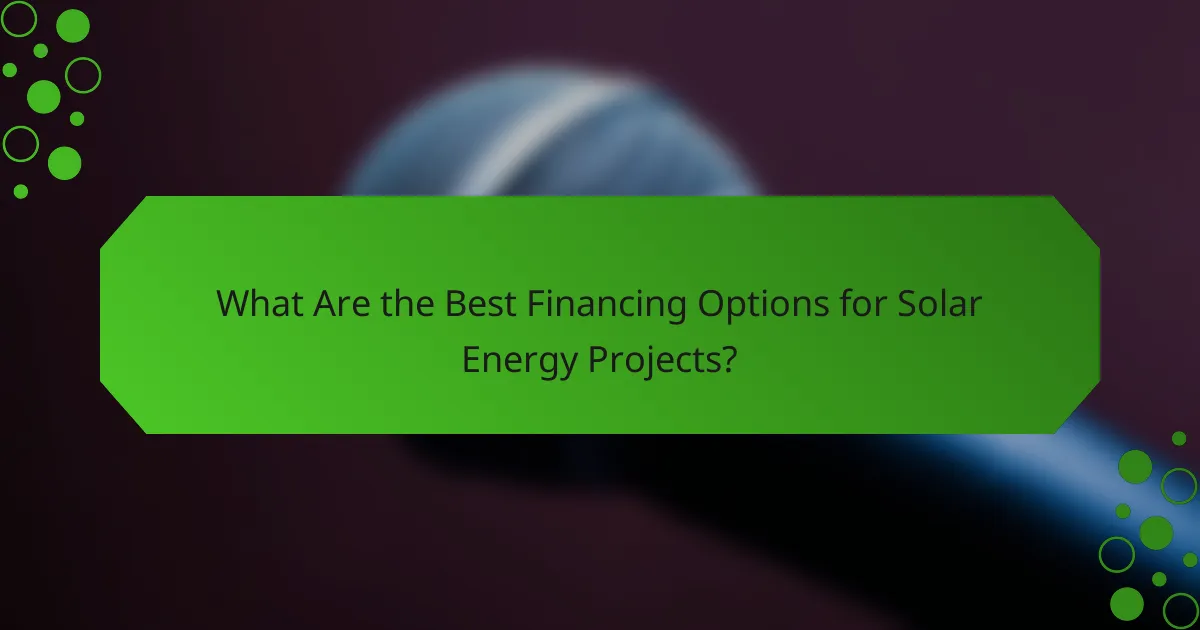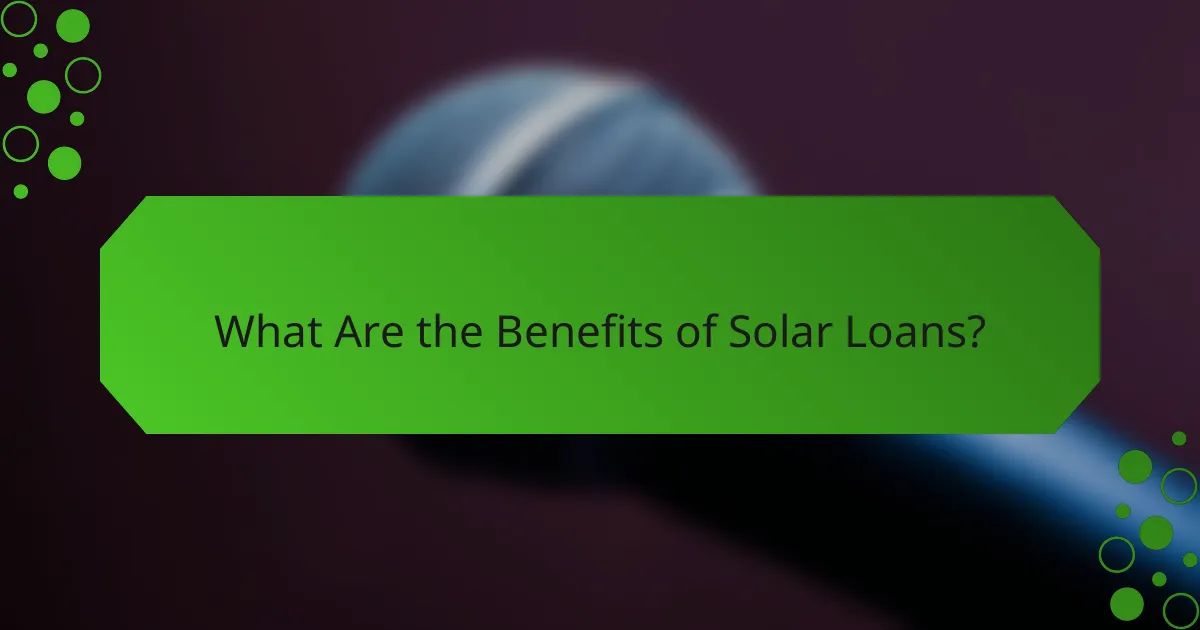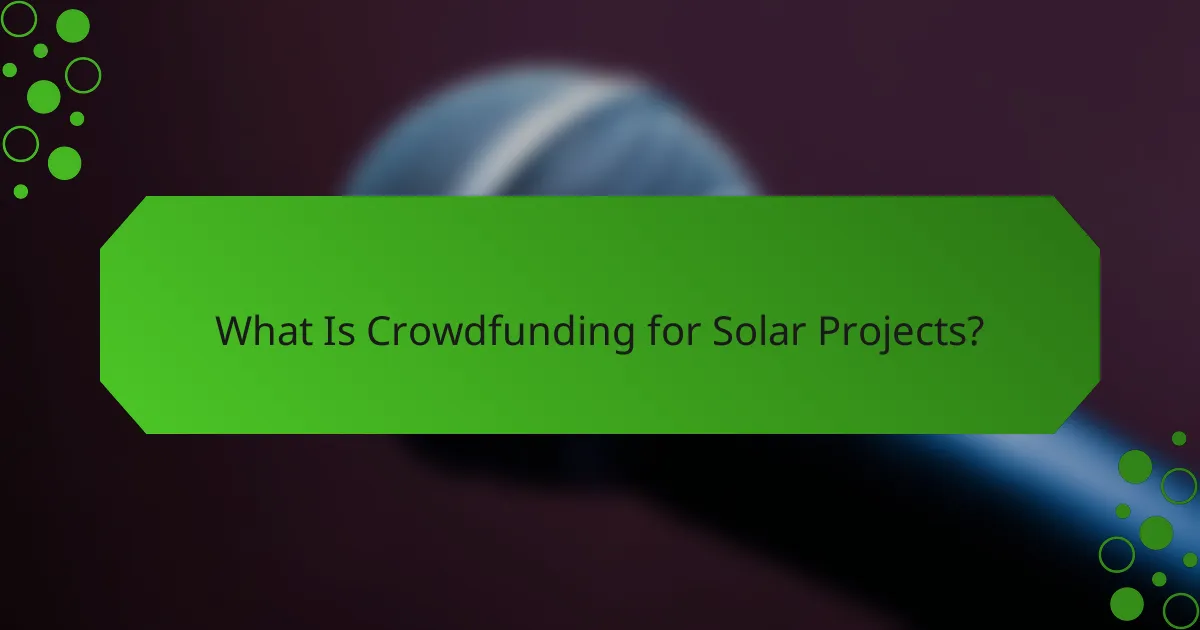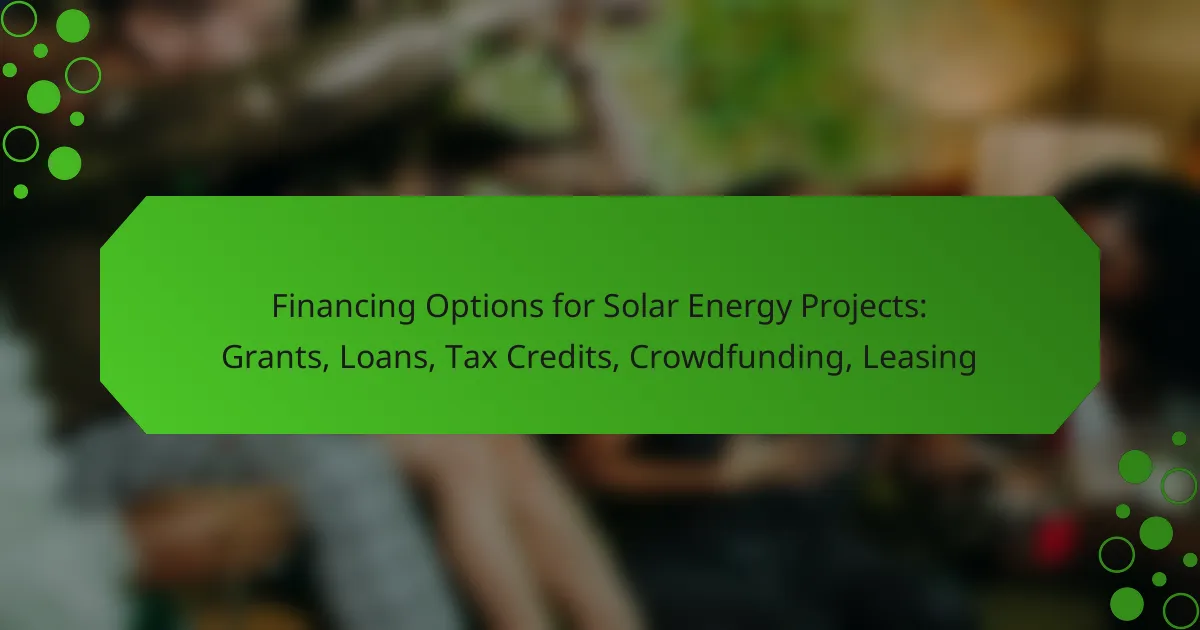Financing options for solar energy projects are diverse, including grants, loans, tax credits, crowdfunding, and leasing. Each of these avenues offers distinct advantages and considerations that can influence the affordability and practicality of solar installations, making it essential for potential investors to evaluate their choices carefully.

What Are the Best Financing Options for Solar Energy Projects?
The best financing options for solar energy projects include grants, loans, tax credits, crowdfunding, and leasing. Each option has unique benefits and considerations that can significantly impact the overall cost and feasibility of solar installations.
Grants for Solar Energy Projects
Grants provide direct funding for solar energy projects without the need for repayment. They are often offered by government agencies, non-profits, or environmental organizations aiming to promote renewable energy.
To qualify for a grant, applicants typically need to demonstrate the project’s potential impact on energy savings or environmental benefits. Research local and national grant opportunities, as they can vary widely in availability and requirements.
Solar Energy Loans
Solar energy loans are financial products specifically designed to help cover the upfront costs of solar installations. These loans can be secured or unsecured and often come with favorable interest rates and terms.
When considering a solar loan, look for options that offer flexible repayment terms and low-interest rates. Many lenders provide loans that can be paid off over several years, making solar energy more accessible for homeowners and businesses.
Tax Credits for Solar Installations
Tax credits reduce the amount of tax owed, directly lowering the overall cost of solar installations. In the United States, the federal solar tax credit allows homeowners to deduct a significant percentage of the installation costs from their federal taxes.
Check the eligibility criteria and deadlines for tax credits in your area, as these can change frequently. Some states also offer additional incentives that can further reduce costs, making it essential to stay informed about local regulations.
Crowdfunding for Solar Initiatives
Crowdfunding allows individuals or organizations to raise small amounts of money from a large number of people to fund solar projects. This method can be particularly effective for community-based solar initiatives or innovative solar technology developments.
Platforms like Kickstarter or GoFundMe can be used to launch crowdfunding campaigns. Clearly outline the project’s goals and benefits to attract potential backers and ensure transparency in how funds will be used.
Leasing Options for Solar Systems
Leasing allows individuals or businesses to use solar systems without the upfront costs associated with purchasing them. In a solar lease, the customer pays a fixed monthly fee for the use of the solar equipment, while the leasing company retains ownership.
Consider the long-term costs and benefits of leasing versus purchasing. While leasing can lower initial expenses, it may result in higher overall costs over time compared to owning the system outright. Evaluate your energy needs and financial situation to determine the best option.

How Do Solar Grants Work?
Solar grants provide financial assistance to individuals or organizations looking to invest in solar energy projects. These funds can help cover installation costs, making solar energy more accessible and affordable.
Eligibility Criteria for Solar Grants
Eligibility for solar grants typically depends on factors such as project type, location, and applicant status. Many grants are aimed at residential homeowners, non-profits, or small businesses, often requiring that the project meets specific environmental or energy efficiency standards.
In the United States, for example, some grants may prioritize projects in low-income areas or those that contribute to community solar initiatives. It’s essential to review the specific requirements of each grant program to determine your eligibility.
Application Process for Solar Grants
The application process for solar grants generally involves several key steps. First, applicants must identify suitable grant programs and ensure they meet the eligibility criteria. This may include gathering documentation such as project plans, cost estimates, and proof of ownership or lease agreements.
Once the necessary information is compiled, applicants can submit their applications, often through an online portal or by mail. After submission, it may take several weeks to months for the grant provider to review applications and announce funding decisions.

What Are the Benefits of Solar Loans?
Solar loans provide a way to finance solar energy projects, allowing homeowners and businesses to install solar systems without paying the full cost upfront. The primary benefits include lower monthly payments compared to traditional financing, potential tax benefits, and increased property value.
Types of Solar Loans Available
There are several types of solar loans available, each catering to different financial needs. Secured loans require collateral, often resulting in lower interest rates, while unsecured loans do not require collateral but may come with higher rates. Additionally, some lenders offer specialized solar loans designed specifically for renewable energy projects.
Another option is a home equity loan or line of credit, which allows homeowners to borrow against their property’s equity. This can provide a larger sum for solar installations but comes with the risk of losing the home if payments are not met.
Interest Rates for Solar Loans
Interest rates for solar loans can vary widely based on the type of loan, the lender, and the borrower’s credit profile. Generally, rates for secured solar loans may range from 3% to 7%, while unsecured loans can be higher, often between 6% and 12%. It’s essential to shop around and compare offers from multiple lenders.
Borrowers should also consider the loan term, as longer terms may lower monthly payments but increase the total interest paid over time. A typical loan term for solar financing can range from 5 to 20 years, depending on the lender and the loan type.

How Do Tax Credits Impact Solar Financing?
Tax credits significantly reduce the overall cost of solar energy projects, making financing more accessible. They provide direct reductions in tax liability, which can enhance cash flow and improve return on investment for solar installations.
Federal Solar Tax Credit (ITC)
The Federal Solar Tax Credit, also known as the Investment Tax Credit (ITC), allows homeowners and businesses to deduct a percentage of the cost of installing a solar energy system from their federal taxes. As of 2023, this credit is set at 30% of the total installation cost, which can lead to substantial savings.
To benefit from the ITC, the solar system must be installed by a qualified contractor and placed in service during the tax year in which the credit is claimed. It’s important to keep all receipts and documentation to substantiate the claim when filing taxes.
State-Specific Tax Incentives
Many states offer additional tax incentives for solar energy projects, which can vary widely in terms of structure and benefits. These incentives may include tax credits, rebates, or exemptions from sales tax, further lowering the cost of solar installations.
For example, states like California and New York provide significant incentives that can complement the federal ITC. Homeowners should research their state’s specific programs and consult with local solar providers to maximize potential savings.

What Is Crowdfunding for Solar Projects?
Crowdfunding for solar projects is a method of raising capital by collecting small amounts of money from a large number of people, typically via online platforms. This approach allows individuals and organizations to fund solar energy initiatives that may not have access to traditional financing options.
Popular Crowdfunding Platforms
Several platforms specialize in crowdfunding for solar energy projects, making it easier for project developers to connect with potential investors. Some of the most notable platforms include Kickstarter, Indiegogo, and specialized sites like SolarShare and SunFunder.
Each platform has its own fee structure and audience, so it’s essential to evaluate which one aligns best with your project goals. For example, Kickstarter operates on an all-or-nothing funding model, while Indiegogo allows flexible funding options.
Success Stories in Solar Crowdfunding
Numerous solar projects have successfully utilized crowdfunding to secure funding. For instance, the SolarShare initiative in Canada raised millions to finance community solar projects, enabling local residents to invest in renewable energy.
Another example is the SunFunder platform, which has funded solar projects in developing countries, helping to provide clean energy access to underserved communities. These success stories illustrate the potential of crowdfunding to drive solar energy adoption and innovation.

What Are the Pros and Cons of Leasing Solar Systems?
Leasing solar systems can be an appealing option for those looking to adopt solar energy without the upfront costs of purchasing a system. This arrangement allows users to benefit from solar power while avoiding maintenance responsibilities, but it also comes with certain limitations.
Benefits of Solar Leasing
One of the primary benefits of solar leasing is the reduced initial investment. Instead of paying tens of thousands of dollars upfront, homeowners can pay a fixed monthly fee, making solar energy more accessible. This option often includes maintenance and repairs, alleviating concerns about system upkeep.
Another advantage is the potential for immediate savings on electricity bills. Many leases are structured so that the monthly payment is lower than the savings generated from reduced utility costs. This can lead to positive cash flow from day one, especially in regions with high electricity rates.
Additionally, leasing can simplify the transition to solar energy. Many leasing companies handle the installation process and provide customer support, allowing homeowners to enjoy the benefits of solar power without the complexities of ownership. This can be particularly appealing for those unfamiliar with solar technology.
